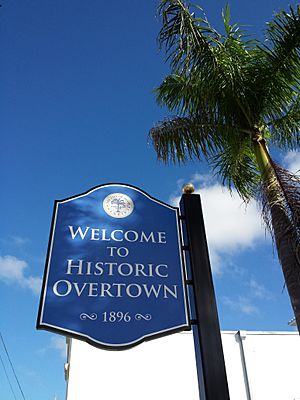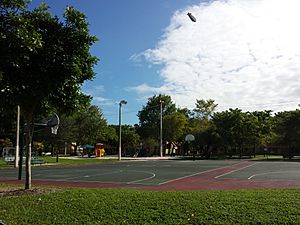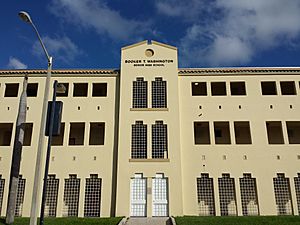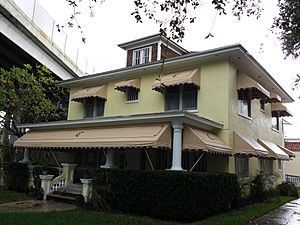Overtown (Miami) facts for kids
Quick facts for kids
Overtown
Central Negro District (historic)
|
|
|---|---|
|
Neighborhood of Miami
|
|
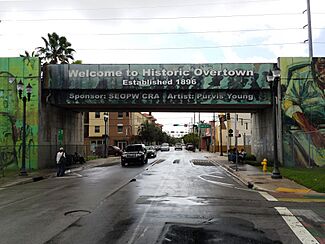
NW 3rd Avenue
|
|
| Nickname(s):
Colored Town (historic name)
|
|
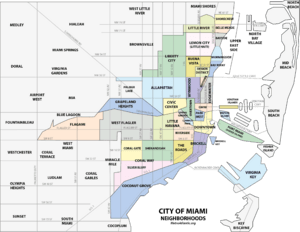
Overtown neighborhood within the City of Miami
|
|
| Country | |
| State | |
| County | Miami-Dade County |
| City | Miami |
| Population
(2010)
|
|
| • Total | 6,736 |
| • Density | 3,410/km2 (8,820/sq mi) |
| • Demonym | Towner |
| Time zone | UTC-05 (EST) |
| ZIP Code |
33136
|
| Area code(s) | 305, 786 |
Overtown is a historic neighborhood in Miami, Florida, located just northwest of Downtown Miami. It was once known as Colored Town during a time when laws separated people based on race. This area was a very important center for business and culture for the black community in Miami and South Florida.
Overtown is bordered by NW 20th Street to the north and NW 5th Street to the south. To the west, you'll find the Miami River, the Dolphin Expressway, and I-95. The Florida East Coast Railway and NW 1st Avenue form its eastern border. People who live here are often called "Towners."
Contents
A Look at Overtown's History
Overtown is a very old part of Miami. When Miami became a city in 1896, this area was set aside for black residents. This happened because Henry Flagler, a railroad builder, had many black workers who settled here. Even though many black men helped vote for Miami to become a city, laws at the time created separate areas for different racial groups.
Overtown's Early Growth and Success
Overtown is the second-oldest neighborhood in Miami that has always been lived in, right after Coconut Grove. It became a busy center for businesses, especially along Northwest Second Avenue. This street was like the main street for the black community. It had the Lyric Theatre, built in 1913, and many other shops. During this time, black residents were not allowed in many white areas like Miami Beach.
In the 1920s, during a time when Florida was growing fast, Overtown was home to D. A. Dorsey. He was one of the first black millionaires in the Southern United States. The first high school for black students south of Palm Beach, Booker T. Washington High School, was also in Overtown. Leaders like Reverend John Culmer worked hard to improve living conditions for people in the area. This led to the creation of Liberty Square in 1937. By the 1940s, Northwest Second Avenue was known as the "Little Broadway" of the South. It had hundreds of black-owned businesses, including libraries, a hospital, and popular nightclubs.
A Hub for Entertainment
Overtown was a lively place for entertainment in Miami during the 1940s and 1950s, after World War II. It was as popular as Miami Beach. Famous black entertainers like Count Basie, Ella Fitzgerald, Cab Calloway, Josephine Baker, Billie Holiday, and Nat King Cole would perform in Miami. However, they were not allowed to stay in fancy hotels like the Fontainebleau. Instead, they found welcoming places to stay in Overtown, such as the Mary Elizabeth Hotel. Many other important black figures, like W. E. B. Du Bois, Zora Neale Hurston, Joe Louis, and Jackie Robinson, also visited and enjoyed Overtown.
Changes and Revitalization
Starting in the late 1950s, Overtown faced tough times. New interstate highways like I-95 were built right through the neighborhood. This split the community and caused many businesses to close. The number of people living in Overtown dropped a lot.
However, in the late 1980s, new projects began to help Overtown. The Miami Arena was built, and the Overtown Metrorail station opened. Since the 1990s, people have worked to make Overtown better. Community gardens were started, and the historic Lyric Theatre was renovated. Dr. Marvin Dunn started the Roots in the City Overtown Community Garden. This project turned an empty lot into a garden that provides fresh food for families and schools. These efforts are helping Overtown grow and thrive again.
In 2015, soccer star David Beckham considered Overtown for a new Major League Soccer stadium. While the team later chose a different spot, this showed the renewed interest in the neighborhood.
Overtown's Population
In 2000, Overtown had a population of 10,029 people. Most residents were Black, making up about 74.77% of the population. About 19.90% were Hispanic or Latino. The average household income was $13,211.99.
Interesting Places to Visit
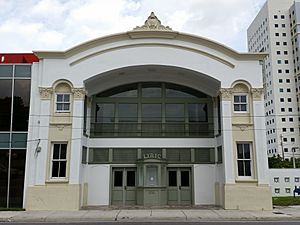
Overtown has many important historic buildings and churches. Some of these are listed on the National Register of Historic Places.
Historic Landmarks
- Dana Albert Dorsey House (250 NW 9th Street): Built in 1913, this was the home of Dana A. Dorsey. He was a very important black businessman and helped many people in Miami.
- Greater Bethel African Methodist Episcopal Church (245 NW 8th Street): Built between 1927 and 1943, this church is home to one of Miami's oldest black congregations.
- Lyric Theater (819 NW 2nd Ave): Built in 1914, this theater was a major center for social life and entertainment in the black community.
- Mt. Zion Baptist Church (301 NW 9th Street): Built from 1928 to 1941, this church also belongs to one of Miami's oldest congregations.
- St. John's Baptist Church (1328 NW 3rd Avenue): Built in 1940, this church is a great example of the Art Deco style.
Other Notable Sites
- Dorsey Memorial Library (100 NW 17th Street): Built in 1941, this was the first library building owned by the city.
- Dr. William A. Chapman House (526 NW 13th Street): Built in 1923, this was the home of Miami's first black doctor.
- Ebenezer Methodist Church (1042 NW 3rd Avenue): Built in 1948, this church shows a Gothic Revival design.
- Hindu Temple (870 NW 11th Street): Built in 1920, this building was inspired by movie sets.
- St. Agnes' Episcopal Church (1750 NW 3rd Avenue): Built from 1923 to 1930, it houses one of Miami's oldest black congregations.
- Ward Rooming House (249 NW 9th Street): Built in 1925, this building is now a gallery and visitor center.
- X-Ray Clinic (171 NW 11th Street): Built in 1939, this was the office for Dr. Samuel H. Johnson, South Florida's first black radiologist.
Parks and Fun Places
Overtown has several parks where you can relax and play:
- Ninth Street Pedestrian Mall, NW 9th Street - NW 2nd Avenue
- Dorsey Park, 1701 NW 1st Ave
- Gibson Park, 401 NW 12th St
- Henry Reeves Park, 600 NW 10th St
- Spring Garden Point Park, 601 NW 7th Street Rd
- Town Park, NW 17th Street - NW 5th Avenue
- Williams Park, 1717 NW 5th Ave
Schools and Other Important Places
Overtown is home to many schools and community centers.
Schools in Overtown
The neighborhood is served by Miami-Dade County Public Schools:
- Frederick Douglass Elementary School, 314 NW 12th St
- Dunbar Elementary School - 505 NW 20th St, Miami, FL 33127
- Paul Laurence Dunbar K-8, 505 NW 20th St
- Phillis Wheatley Elementary School, 1801 NW 1st Pl
- Booker T. Washington Senior High School, 1200 NW 6th Ave
- Theodore R. and Thelma A. Gibson Charter School, 1682 NW 4th Ave
Libraries for Learning
- Overtown Public Library (350 NW 13th St): This library has amazing paintings by the famous artist Purvis Young on its outside walls.
- Dorsey Memorial Library (100 NW 17th St): From 1941 to 1961, this was the first city-owned building built just for a library.
Museums to Explore
- Black Police Precinct & Courthouse Museum, 480 NW 11th St: This museum teaches about the history of black police officers and the justice system.
Places of Worship
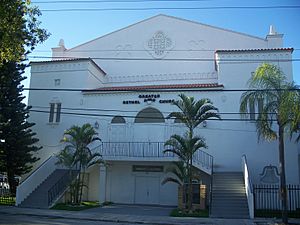
Overtown has many churches, reflecting its strong community spirit:
- A.M. Cohen Temple Church of God in Christ, 1747 NW 3rd Ave
- Christ Church of The Living God, 225 NW 14th Ter
- Greater Israel Bethel Primitive Baptist Church, 160 NW 18th St
- Greater Mercy Missionary Baptist Church, 1135 NW 3rd Ave
- Mt. Olivette Baptist Church, 1450 NW 1st Ct
- New Hope Primitive Baptist Church, 1301 NW 1st Pl
- Saint Peter's Antiochian Orthodox Catholic Church, 1811 NW 4th Ct
- St. Francis Xavier Catholic Church, 1682 NW 4th Ave
- Temple Baptist Church, 1723 NW 3rd Ave
- Triumph The Church and Kingdom of God in Christ, 1752 NW 1st Ct
Community Centers
- Miami-Dade County - Culmer Neighborhood Service Center, 1600 NW 3rd Ave
- City of Miami - Overtown Neighborhood Enhancement Team, 1490 NW 3rd Ave Suite 112-B
- Southeast Overtown/Park West Community Redevelopment Agency, 1490 NW 3rd Ave Ste 105
- Overtown Youth Center, 450 NW 14th St NW 3rd Ave
Getting Around Overtown
Transportation Options
Overtown is served by the Miami Metrorail system, making it easy to travel to and from the neighborhood. You can find stations at:
- Historic Overtown/Lyric Theatre (NW Eighth Street and First Avenue)
- Culmer (NW 11th Street and US 441)
Images for kids
-
D.A. Dorsey House, built in 1914
-
Mt. Zion Baptist Church, 1928


